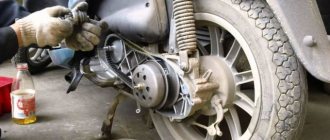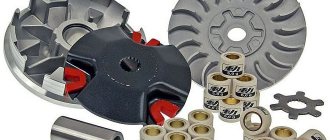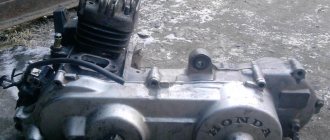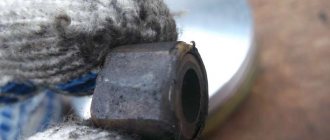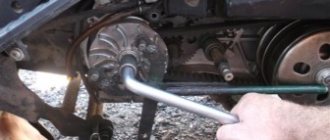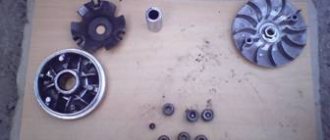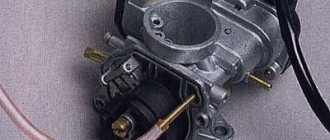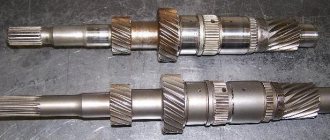Production of the Jatco JF011 variator began in 2005. Until 2014, it was installed on many models of different brands. And, perhaps, this is the most popular variator on our market. It is found on many Japanese cars: Nissan Qashqai, Teana and X-Trail, Mitsubishi Lancer, Galant, ASX and Outlander, Suzuki Kizashi, European: Renault Koleos, Citroen C-Crosser and Peugeot 4007 and even on American: Jeep Compass and Dodge Caliber .
The variator is compact and has fewer parts than a hydromechanical gearbox.
The variator is compact and has fewer parts than a hydromechanical gearbox.
What if you handle it with care?
This variator became the next link behind the very reliable units of the first generation (RE0F06A), which we did not see - of course, with the exception of those who brought right-hand drive cars from Japan. Its descendant, JF016, is now installed on many cars, and it is considered more capricious and unreliable.
With proper operation, the Jatco JF011 variator runs for a long time: problem-free runs of up to 180,000 km are known.
The main thing is not to overload the variator, change the working fluid every 45,000 km and contact specialists at the first sign of a malfunction. CVT repair is not a cheap operation. But usually it costs no more to repair it than a hydromechanical automatic machine.
- The whole truth about the (un)reliability of CVTs is in this publication.
Photo: manufacturing companies
5 main malfunctions of the Jatco JF011 variator
Typical diseases of CVTs
Push Belt, PushBeltOnly one company can produce all “pushbelts” for CVTs. They are made of several metal strips on which steel pushing segments are strung. These segments cling with their jagged surface to the metal of the cones and pull the multilayer tape hooked to them.
The tape has a connecting function here, which presses the segments against the cones and holds them tightly together.
The segments perform the function not of a tug (which pulls), but of a “pusher”. Like the wheels of a steam locomotive pushing off steel rails. It is the place of metal-to-metal contact that is the weakest point of the belt. The notch functions as a “protector”, which displaces excess water (oil in our case) and clings to the metal of the cones with its teeth.
The second weak point of the belt is the belts, or rather their deformation/stretching or (if neglected) rupture. But this happens when the segments have already worn out beyond a critical level.
Belt diseases develop according to the following scenario:
The most dangerous modes of operation of the cone belt are at the beginning of movement. When the gear ratio is maximum or minimum (at the beginning of acceleration or at maximum speed), one of the cones has a minimum contact area with the belt and then there is a high risk of the belt slipping.
Normal operation is when the entire surface of the segment comes into contact with the cone at an angle of 90° and there is no slipping either when the segments enter or exit the cone.
The belt strips experience enormous tensile and bending loads (just as we break electrical wires by bending and unbending them several times) and over time, the metal of the belts stretches and gets tired. And when the tapes are stretched, the gap between the segments increases, albeit by a few microns, but this leads to the fact that the inclination of the segment to the cone becomes less than 90° and contact occurs not with the entire surface of the segment, but with the front edge. And then the slip starts earlier and earlier.
The computer records the slippage. At the same time, the pump receives a computer command to increase the pressure of the belt against the cones, which greatly increases the stretch of the belt and begins a chain reaction of wear on the tread segments. But what is much worse is the wear of the surface of the cones.
In addition, the profile of the pushing segment itself is extremely important. Normally it has a notch. As the notch wears out, it becomes less noticeable and when it wears down to the base, a slip occurs with every strong press of the gas pedal. On the right you can see the different levels of belt wear.
Risk factors when the belt slips: A. at the moment of starting , when the belt bending radius is minimal and the variator gear ratio is at a minimum (LowGear). B. At maximum rotation speed (Overdrive), when the radius of the belt on the driven cone is minimal, and the rotation speed and torque are maximum, which creates additional centrifugal forces for the belt. B. When working on unheated oil , when a thick layer of cold (up to 60°C) oil on the cones promotes sliding, but does not yet “glue” the metal of the segments to the metal of the cones. D. a worn belt with stretched bands and eaten segment protectors. D. working in dirty oil , when dust from friction clutches or, worse, metal dust gets under the belt.
Content
- Oil check
- Check in motion
- Sound check
A CVT is similar to an automatic gearbox in that you do not need to set the speed yourself using the transmission lever. However, in its operation it has significant differences: if the “automatic” includes fixed gears, usually in the number of four to nine, then the variator is a continuously variable transmission that does not have fixed steps.
In other words, if an automatic transmission alternately includes fixed stages, then the variator works from the lower to the upper threshold, without having intermediate “stops” on the way to increasing the gear ratio.
So, in what ways can the variator be checked if you have already met with the seller and are inspecting the car:
- checking the oil in the variator;
- check in motion;
- sound check.
The second and third methods may seem similar, but they are only adjacent; one may not give a complete picture without the other.
Despite the fact that a standard “automatic” with a torque converter is considered the preferred transmission option, a variator is considered more modern, although it is not without its flaws and shortcomings, and in some ways is inferior to an automatic transmission.
Let's talk in more detail about ways to check the variator.
A little trick when checking the variator
Before inspecting the car, ask the owner to take you for a ride. It is advisable to do this not as a test drive, but as a simple trip.
Pretend to be a “felt boot” and ask the seller to pick you up from the station, for example, or from another place. Drive his car to the inspection site. This way you will see the owner's driving style. If he likes to “fry” the car, then you will already be ready for the nuances of checking the variator.
During a test drive, if you ask him for a ride for this purpose, he will be careful, his driving style may be radically different from everyday.
What causes a variator to break down?
The main cause of known malfunctions of CVTs is violation of basic operating rules:
Additional causes of malfunctions can be various defects in structural components (defects, ill-conceived design, poor-quality connection), as well as natural physical wear and tear of the constituent elements, which manifests itself after 150,000 - 200,000 km.
CVT malfunctions can occur both in its electronic control module and in mechanical components.
Electronics defects
In the first case, detection of a specific breakdown is carried out using computer diagnostics. A diagnostic code is assigned to each defect. Thus it is easy to determine:
The probable cause of a defect in the electronics may also be a violation of the integrity of the electrical wiring or unreliable contact in the connector.
Mechanical problems
Computer diagnostic tools are not the only tools used to detect mechanical problems. In this case, it is necessary to approach the problem in a comprehensive manner and monitor the parameters of the working fluid, conduct road tests, read the diagnostic code, and clarify signs of malfunctions.
How to replace a variator belt with your own hands
First, let's look at the tools needed to replace the CVT drive belt. So, you will need: a hammer, an impact screwdriver, keys 10, 11, 14, six clamps, a wide free table, a camera. Important! You need to prepare plastic containers to store the removed parts. It is also necessary to place the bowls in the order in which the elements are dismantled, make explanatory notes, and take photos in difficult moments. These precautions will help you install the device without any problems.
Sequence of actions when replacing the belt:
- Unscrew the six bolts of the transfer case cover and remove it by carefully prying it up with a screwdriver. Get the part - a helical double-bearing gear. Place all the formed elements into a container (and 6 pieces of bolts), make an inscription.
- Turn the box over, remove the shaft and a fragment of the box body. Unscrew the bolts.
- Slowly tap the cover around the perimeter with a hammer and remove it.
- Remove the two gears. Continue sequentially folding the parts into different containers, using the principle of each assembly unit in a separate bowl. It is mandatory to sign them.
- Unscrew the screws that secure the pump housing, remove its chain and gear. Next, you can easily remove the oil pump cover.
- Next you need to get the shaft. All. One side of the variator box is ready. Now you should turn the box over and unscrew the bolts that hold the lid. Also carefully, using a screwdriver, you need to wring it out and remove it. Here is a system for steplessly changing the gear ratio between the shafts, that is, a variator unit - 2 shafts, a belt, which, in fact, we will replace.
- Tighten the belt in a couple of places, using plastic straps to prevent it from breaking during removal.
- Take your time to get the pulleys and belt. Be careful not to allow any debris to get into these openings. Place the pulleys on the table, pull one of them firmly and release them from the belt. Put on the new element and reassemble.
Misconception 2. The variator has a belt
Most designs actually use a belt made up of a large number of steel plates held in place by a belt. But some manufacturers prefer to use a chain. It looks almost the same as an engine timing chain. Only contacts the cones. Torque is transmitted by the ends of the rods connecting the plates. Such a variator is called a chain variator. Chain CVTs are used, for example, by Subaru and Audi.
The Subarov variator uses a chain drive. This design can withstand more torque than the belt can transmit.
The Subarov variator uses a chain drive. This design can withstand more torque than the belt can transmit.
Misconception 7. The CVT has no steps
Yes and no at the same time. This postulate is refuted by gearboxes that have both a belt variator and a two-stage gearbox. Our car enthusiasts first saw it on the Nissan Juke, and now it has reached the Lada Vesta. It is produced by Jatco (Japan), index - JF015E. The bottom line is that the variator provides approximately half of the entire speed range in first gear, and then, when moving to second, it again realizes its range. Thus, in the classical sense, this variator has two gears. But most transmissions like this are also trained to simulate five or six gears electronically. These programs are, of course, “not real”, virtual.
Toyota's newest Direct Shift-CVT uses gear first gear and then engages a belt with cones.
Toyota's newest Direct Shift-CVT uses gear first gear and then engages a belt with cones.
Thermal mode
The temperature regime in CVTs should be observed especially carefully. This function is assigned to the self-diagnosis system and is carried out using a temperature sensor. If the limit value is exceeded, a fault signal lights up on the dashboard with the simultaneous transition of the variator to an emergency state.
In order to ensure optimal oil temperature, on most cars, in addition to the main heat exchanger, another radiator is connected. It is mounted in the front area of the engine compartment up to the climate system condenser. Through the air ducts located in the bumper, it is often clogged with various debris - poplar fluff, leaves, dirt, gravel, midges, etc. The first manifestation of its critical contamination is severe overheating when traveling at high speeds. Once every two years it is necessary to clean and wash it very thoroughly. It's best to have the bumper disconnected. It is also recommended to cover the external entrances of the air ducts with protective nets, since the radiator is susceptible to damage from anything that flies from under the wheels.
According to the collected statistical data, failures of variators occur no more often than failures of hydromechanical units. Even the most cautious manufacturers, who were previously quite skeptical about the reliability of CVTs, began to use them in the power units of their popular models. For example, Toyota - on the restyled RAV4, Subaru - on Forester, XV and Outback. The owners of this brand can hardly be called slow drivers. Constant driving over rough terrain and powerful accelerations were recently considered unacceptable for the operation of CVTs. It seems that times are changing, so the prospects are brighter for them.
Source
Checking the presence of a tow bar
No matter how strange it may sound, its presence can significantly shorten the life of a continuously variable transmission. The design feature of a V-belt variator involves transmitting torque through a belt. If the vehicle is pulling large loads: loaded trailers, motorhomes, etc., belt slippage may occur. This will already lead to scoring on the cones and expensive repairs.
Important. The seller, knowing about the problem with the tow bar, could have removed it before selling it. Therefore, before buying a used car with a CVT, look under the rear of the car to see if there are mounts for a hook.
Visual inspection
We take our eyes and open the hood. We are interested in two things here:
- External condition of the gearbox;
- The condition of its cooling radiators.
If the engine is located transversely, then the gearbox is on the left side if you stand with your back to the car. We inspect the transmission from above, especially the place where it connects to the engine.
We pay attention to the color of the sealant and the method of its installation. The factory uses pink sealant and it is laid neatly so that excess does not hang out on all sides. If the variator was removed from the engine, then, in most cases, the sealant is gray. No one will bother using factory sealant, it is expensive.
The junction of the box with the internal combustion engine must be dry. Any oil leaks indicate possible problems. When visually checking the variator, it should be completely dry on top. If there is a lift, we inspect this place from below. It should be dry there too.
We look at the condition of the transmission oil cooling radiators . In some models, automakers make do with a heat exchanger, but in our case they are there. The first radiator is located behind the left headlight at the bottom, not to be confused with the engine radiators.
There should be no oil stains or leaks on it. The same applies to its fittings and transmission cooling hose. It is difficult to look into this place from above; it is better to inspect from below on a lift or inspection pit.
Caring owners install an additional cooling radiator. It is located in front of the engine cooling radiators. We inspect it for oil leaks.
If an additional radiator is installed on the car, this is a sign of the caring attitude of the owner.
Bearing wear
This is the most common defect in CVT cones. It manifests itself with a characteristic hum after a run of at least 50,000 km.
The belt is assembled from numerous plates interconnected by steel constrictions. With its side surfaces, with subtle oblique notches applied to improve adhesion, it comes into contact with the pulley cones. During operation, the notches wear out, which can ultimately lead to serious damage. Therefore, even the elimination of humming bearings should be accompanied by a preventive replacement of the belt, which guarantees the preservation of serviceable pulleys.
Bearing noise can also occur for several other reasons:
- Poorly manufactured bearings.
- Insufficient dynamic load capacity, as well as a low degree of bearing accuracy, lead to their overload and destruction.
- Penetration of wear products (small powder-forming particles) onto working surfaces, leading to destruction of the latter. This may be due to a large amount of metal powder clogging oil filters and weakening the field of the magnet installed to collect it. In some cases, this problem can be solved by changing the oil more frequently (approximately every 30,000 - 50,000 km).
There is no consensus among manufacturers on this issue. For example, Mitsubishi strongly recommends changing the oil every 75,000 km, while Renault-Nissan only allows monitoring its level and condition during the warranty period (100,000 km).
CVT oil is marked with the abbreviation CVT. Every car manufacturer has such oil. The original composition from Nissan is produced under the symbol NS-2. Mitsubishi is promoting the DiaQueen CVT-J1. The analogue from Renault is known as ELFMATIC CVT. Honda produces HMMF and CVT-F, VAG produces ATF CVT. All these fluids are recommended specifically for CVTs. It is absolutely unacceptable to use oils intended for hydromechanical automatic transmissions.
The amount of oil required for filling is determined by the type of drive and power unit. For example, for a front-wheel drive Qashqai with a 2-liter engine not equipped with an oil cooler, approximately 4.2 liters are required. A couple of liters will “get stuck” between the transformer elements and the hydraulic system components, since it is impossible to pump out these “drops” using the standard draining procedure. To completely renew the filling, they use the replacement method, using an appropriate installation and three times the volume of working fluid.
Smooth ride
The next most common defect occurs in the form of jerking and jerking of the car. The responsibility lies with the pressure reducing valve located in the oil pump.
The latter begins to function when the engine starts. The pump is manufactured as a monolithic unit and in the event of a defect in the pressure relief valve, it must be completely replaced. During normal operation, the valve should move freely in a mating sleeve pressed into the pump housing. Constant contact of the valve working surface with abrasive particles of wear products falling on it leads to the formation of many longitudinal scratches. When worn, the valve begins to jam so much that subsequently it is difficult to pull it out even with pliers.
The result is abnormal pressure, leading to disruption of the coordinated operation of the pulleys. This causes the belt to slip. Timely contacting the service allows you to reduce financial costs. Minor damage to the cones can be corrected by grinding. The belt must be replaced.
The most famous CVT oil sold in car dealerships is the product from Nissan NS-2 in a two-liter tin. The container of the new issue is silver, the old one is painted blue. In no case should it be confused with the old, completely incompatible NS-1 oil, bottled in pink containers.
Extreme enthusiasts who are accustomed to pulling out a stuck car by rocking with instant alternate switching of the lever from position D to R and back run the risk of encountering another problem - unpleasant jolts during the process of switching from the “parking” position to D or R. In this mode, there is practically no pause when switching. between positions D and R, although ideally a complete stop of the car is required. As a result, increased wear of the coupling spline joints inside the planetary gear in contact with the friction discs occurs. The result is the need to replace the planetary gears.
Oil check
The variator box, or CVT as it is called, contains a special fluid - oil, which allows the box to operate smoothly and silently. Checking the fluid in the variator is the most reliable way to obtain comprehensive information about the condition and performance of the transmission.
Checking the oil is carried out in the same way as, say, on an engine - using the usual oil dipstick. However, it is important to take into account that in the case of a variator, the oil must be checked with two marks on the dipstick, one is responsible for the “cold” condition, the other - when the variator is warm.
If the fluid level is normal, you should proceed to checking the oil color. Ideally, it should be transparent, but there is a possibility that the oil will be dark or cloudy.
If the oil is not clear, this means either that the owner does not care for the car and neglects the need to service the continuously variable transmission, or the variator is used in very heavy duty, which speaks of the owner as a driver who is “killing” the car with his driving style. At the very least, it has a detrimental effect on the condition of the gearbox.
Even if the oil turns out to be transparent, do not rush to celebrate your victory - you also need to make sure that there are no foreign particles in it. If even in absolutely transparent oil you can notice veins, clots and lumps, this will mean that the variator is already very worn out, and it is possible that in the near future we will be talking about serious repairs, or even replacing the gearbox.
You might not want to, but if you want to be sure of everything, you need to smell the oil from the variator. The smell will tell you a lot, such as if the oil smells burnt. This means that the variator was operated incorrectly and under critical loads.
Therefore, it is necessary to check the oil for:
- transparency;
- presence of foreign substances;
- smell.
Based on this number of factors, you will be able to determine whether you have taken care of the demanding gearbox, or whether you have left everything to chance, which can lead to costly repairs in the future. Whether you need to buy a car with such symptoms, decide for yourself, of course, but if something is wrong, we advise you to refrain.
Even if the oil turns out to be transparent, clean and without a burning smell, we advise you not to stop there and continue checking while the car is running.
Repair prices
The most common breakdowns and the cost of fixing them:
- Cone bearings are more likely to suffer from metal shavings than from other causes. Statistically, the Nissan Qashqai has the “weakest” bearings, but the Nissan X-Trail shows greater durability;
- In Subaru, the bearings are structurally integral with the cones, which significantly increases the cost of repairs, the price is about $400 for a normal brand. But it’s still more profitable than a new gearbox;
- Replacing the belt (chain) is done once every 100 thousand km. The estimated price of a new part can vary: from $50 for a budget brand to 300-400 or more for an original (for example, Honda or Toyota);
- The oil pump valve is inexpensive, 10-20 dollars , but removal, disassembly and replacement will take quite a lot of time;
- A valve body (for example, on a Nissan Teana or Murano) starts at $300 . However, hydraulic units rarely fail;
- And finally, oil filters are cheap consumables, costing 10-30 dollars apiece, and not changing them is simply a crime against your car.
